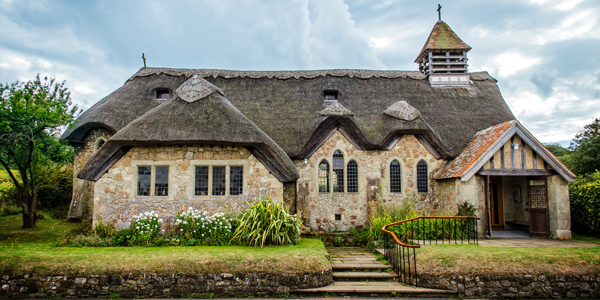Over the past few months, we’ve received an influx of insurance-related enquiries from clients planning to renovate their thatched properties. As such, we thought we’d take a look at some of the challenges you can expect to face when renovating this type of property.
Thatched properties have been enjoying somewhat of a revival in Britain lately as more and more homeowners and property developers succumb to their rustic charm.
Not only are these stunning thatched properties beautiful examples of rural England, what’s so interesting about them is that their thatching style and the materials used in their construction varies so much – not just from one part of Britain to the next, but also within the various regions themselves.
Thatched houses: a renovation challenge
Although there are certainly a few more issues that need taking into account when renovating a thatched property, we can assure you that the benefits of owning your very own thatched property far outweigh the additional effort expended on renovating these properties to you own high standards.
Here is a selection of just some of the challenges associated with renovating a thatched property that you should be aware of.
1. Listing status: Did you know that of the 30,000 thatched properties found in England, around 24,000 of these are listed? Where your property is listed, typically the higher grades of listing tend to be subject to stricter controls and permissions by English Heritage. This may also include a certain amount of interest in the interior or the property as well as the exterior.
Also, try not to be too surprised if the particular listing status of your thatched property increases its rebuild value by a factor of as much as 3 time over and above what insuring a building of standard modern construction would cost! You can find out whether your thatched building is listed by taking a look at the National Heritage list for England.
2. Insuring existing structures: When insurance companies arrive at the premium they want to charge for your property, they look at a number of factors. The premium you pay is affected not only by your building’s listed status (see above) but also by the materials from which it’s constructed. In insurance terms, a thatched roof (whether it’s made from long straw, combed wheat reed or water reed) is considered to be a non-standard type of construction. So too are timber frames – found in many thatched properties.
Since insurers want to assess the likelihood of your property being susceptible to certain types of loss (especially loss caused by fire, which is a real risk in domestic, thatched properties) what your building is made of has quite a bearing on the insurance premium and the way insurers regard the risk. For more information on insuring existing structures, please take a look at our handy Knowledge Base section.
3. Rising damp: Thatched houses tend to be more susceptible to damp. This is especially the case where a property hasn’t been lived in for a while or has fallen into disrepair. Particularly bad cases of damp could mean that the plasterwork is damaged or that the property’s timber frame has begun to rot away. This is why we always advise you to invite your local planner and conservation office round to discuss the extent of the works with you and to advise on what work would be possible on your particular building.
4. Plan ahead: If you are planning to renovate your thatched property, it pays to be organised and contact your preferred thatcher well in advance. Since there are now a limited number of people doing this trade, in some parts of the country (such as the West Country) it can take as long as 12-18 months before a busy thatcher is able to get round to starting work on your property. When choosing your thatcher, make sure they’re registered with the National Society of Master Thatchers. You can find a registered thatcher here.
4. Fire protection: Although construction sites in general are rather vulnerable to fire, this is certainly the case when renovating a thatched property. That’s why, in 1992 the Joint Fire Code was first published. The code provides guidance on fire safety on site as well as the prevention and detection of fire. This code covers all activities – from the design to the construction phases.
It’s particularly good for thatched house owners to take this code into account since, where you comply with the regulations, this may help lead to a reduction in your insurance premiums. For more information on fire protection, take a look at this recent blog post on fighting fire practice codes and renovation insurance.
If you’re planning on renovating your thatched property, we here at Renovation Insurance Brokers can help make sure that your property is properly insured – just in case (in the unlikely event) you find yourself in a similar situation to these poor property owners whose 400-year-old thatched cottage in Devon collapsed during renovation work!
For more information on insuring your renovation project, contact us today. Our team of insurance specialists will be happy to help find the right renovation insurance package for you.
Photo Credit: Garry Knight





